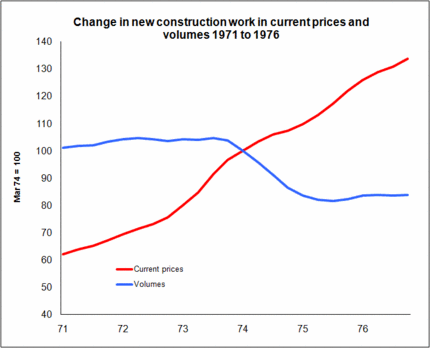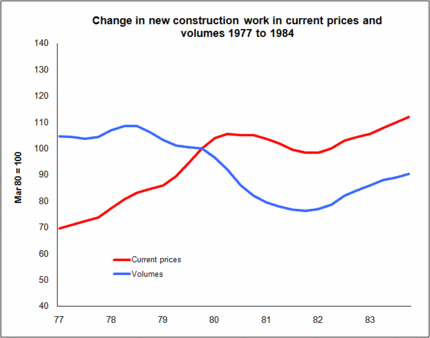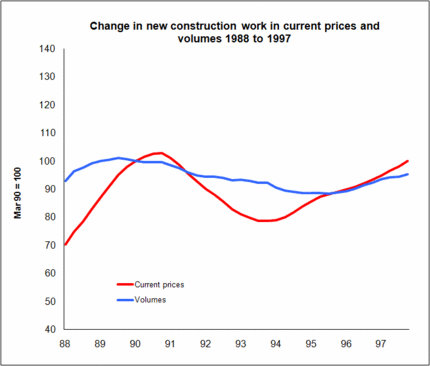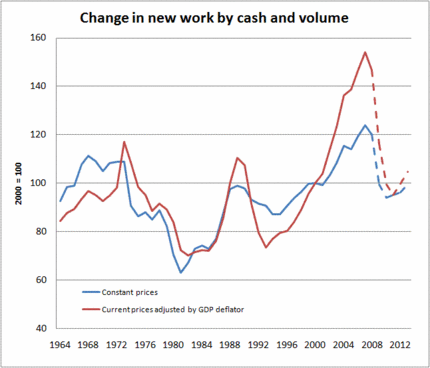Contractors face a £24 billion drop in new work
UK contractors should prepare themselves for a £24 billion drop in the annual cash value of new work coming through as the recession reaches its expected bottom in 2011.
Shrinking volumes and plunging prices threaten to drag the cash spent on buying new construction work down from £70 billion in 2007 to £46 billion in 2011.
To put that drop in perspective it is rather like losing about three times the total construction budget of the London Olympics all in one year.
That at least is the implication of a piece of number doodling I have been doing based on current forecasts of workload and tender prices, historical data and some fairly conservative assumptions.
I have for the purposes of this exercise ignored the rather complex repair maintenance and improvement contribution to construction, which added about £56 billion to the coffers of the construction industry in 2008.
The quick fag packet sums are fairly easy. Take, for example, the Construction Products Association forecast of a 23% fall in new work between 2007 and 2011 and then adjust that for the 15% drop in tender prices expected by BCIS and you have the cash value of work dropping to about 65%.
Obviously it is not that simple, but crudely the number will be in the right ball park. Sadly the more rigorous you are the worse the numbers appear to be.
There will of course be those who draw some consolation from the link between supply, demand and price. If prices drop there is the possibility that work will be commissioned that otherwise would not have been.
And I will add that we are, as with all the data, subject to the vagaries of collection and treatment, but they are the best available at short notice.
Still, let’s get back to the number doodling and the implications.
I have banged on many a time about the likely dangers of the main players in construction following the path taken in the previous recession that led to the drop in prices being, in my opinion, more damaging to the fabric of the industry than the drop in workloads.
And it seems we are back into a phase of suicidal bidding. Not that this is an unexpected turn. We have been on the path for some while towards the unsavoury practices of suicidal bidding, ludicrously long bid lists, Dutch auctioning and whatever else can be invented to drive prices down.
For the past 15 years and some I have argued it was not falling workloads that hurt the industry in the 1990s but falling prices and the consequences of sub-economic pricing spilling down the supply chain.
After a bit of number crunching I have put together some graphs that may help to illustrate why, despite the 1990s being a shallower recession (particularly as far as new work is concerned) than some that went before, it was regarded at the time as the worse recession since the Second World War.
Using various bits of data and forecasts around I have plotted some lines and assembled a rough projection. It’s a bit string and sticking plaster, but sufficiently robust for these purposes and significantly more robust than stuff I have seen passed off as research within the construction industry.
The first three graphs are pretty straightforward, plotting change in current price output against constant price output for three past recessions.



What you see is that in the 1970s there was no fall in the actual £s spent on construction, we had high inflation. In the early 1980s there was a slight drop in the cash value of work.
But in the 1990s the cash value of work plunged far more than the volume. Prices collapsed and this hurt the contractors and everyone else within the supply chain, excepting a few lawyers perhaps who were hard pressed dealing with the litigation created by the resultant infighting.
What I have done for graph four is to make some assumptions based on history, the Construction Products Association forecast and the forecast of a 14.9% drop in tender prices forecast by BCIS.
And here I must thank Joe Martin at BCIS for providing me with some back data on tender prices and output prices for new work. What was most interesting about these figures was that the 23% drop in tender prices in the 90s recession was followed by a 27% peak to trough drop in output prices.
So that I could compare the current price figures graphically with the constant price or volume figures I have used GDP deflators to adjust the current prices. This, sort of, adjusts for general inflation and gives you an approximation to a “real” price for the construction.
What comes across is that the rise and fall of construction volumes in the late 1980s and early 1990s created a much larger wave in the cash value of construction work undertaken. This was not quite so evident in the earlier years.
I have played about to get a projection of what might happen to the cash value of construction based on the bits and pieces of data I have strung together. I’d describe the prospects as “ugly” as you can see…

Of course I am just speculating here, but I have long suspected that it was the effect of a large drop in money coming into the industry more than the lesser drop in workload that damaged the industry in the 1990s and why the recession then felt much worse than recessions in the past.
I will return to possible explanations of why this “squeeze” in cash (or price elasticity as economists might say) should have been so pronounced in the 1990s recession compared with in earlier downturns.
But the behaviour that leads to sub-economic pricing is bemusing. Frankly, shareholders are only fussed about how much work you are doing in as much as it reflects on how much cash you are dragging in the door. Their real concern is profit. And there was not much of that to be had in the early 1990s.
What these figures say to me is that more attention needs to be paid to how we can contain potential destructive falls in prices. That it seems is of greater pertinence than how much money we can get out of a cash-strapped Government in the hope it will bail us out of the mess we are in.